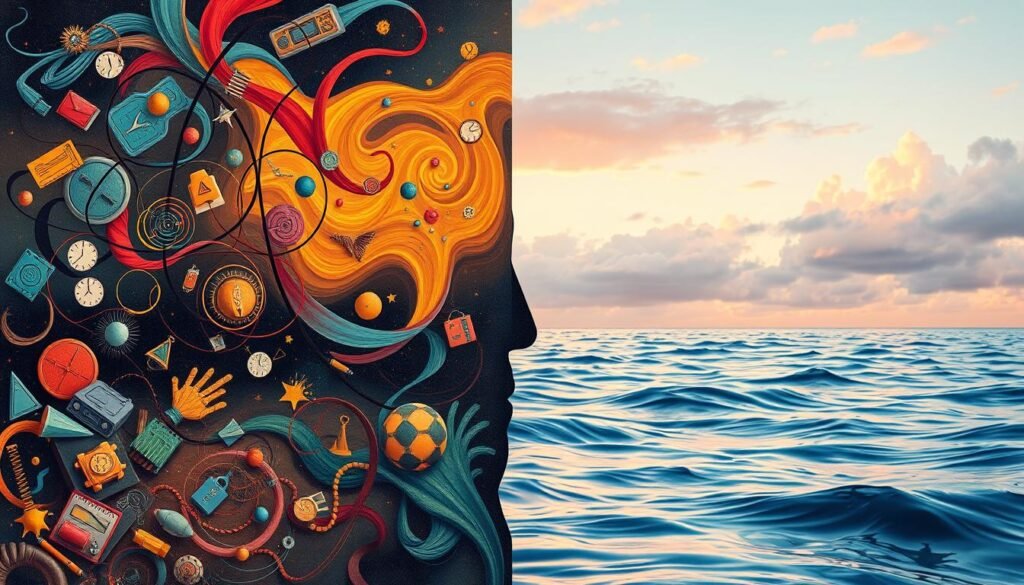Did you know that up to 50% of people with ADHD might also feel anxious? It’s tough to tell anxiety from ADHD because they look so similar. Both can really change how someone lives day-to-day, but they’re often not spotted or wrongly labeled.
We’re diving into how to spot the signs of anxiety or ADHD. We want you to know what to look for and see how they’re related. It’s key to getting the right help when you need it, all for better handling of these conditions.
Key Takeaways
- Knowing the difference between anxiety and ADHD helps in handling them well.
- It’s common for someone to have both anxiety and ADHD, which makes a correct diagnosis important.
- Since their symptoms can look a lot alike, it’s easy to mix them up.
- Getting help early can make a big difference for those with either or both issues.
- Ways to manage behavior can help deal with the struggles of anxiety or ADHD.
Understanding ADHD and Its Symptoms
ADHD stands for attention-deficit/hyperactivity disorder. It is a neurodevelopmental disorder that affects both kids and adults. It shows up as ongoing inattention, impulsivity, and sometimes hyperactivity. Knowing the symptoms is key for handling and support.
Overview of ADHD as a Neurodevelopmental Disorder
ADHD changes the way a person thinks and acts. It comes in forms like inattentive ADHD and hyperactive-impulsive ADHD. Boys tend to be diagnosed more than girls, possibly because symptoms vary between genders. Many with ADHD also deal with conditions like anxiety or learning disabilities.
Characteristics of Persistent Inattention and Impulsivity
Having trouble focusing, forgetting things, and getting easily sidetracked are signs of inattention. Acts of impulsivity include interrupting and not waiting turns. These traits disrupt daily life and can increase anxiety about work or school. Struggling to pay attention and control impulses may also cause sleep problems.
Common Misconceptions About ADHD
There are many myths about ADHD. Some think it’s just for kids or an excuse for bad behavior. But the way we talk about ADHD has changed, showing its true complexity. It’s important to know ADHD can last into adulthood and may not always look the same as in kids. For more info, check out Mayo Clinic’s overview of adult ADHD.
Anxiety Disorders Explained
Anxiety disorders include many mental health conditions marked by too much worry and fear. Generalized anxiety disorder (GAD) is a key example, affecting many areas of life. It’s important to know about GAD, especially because it might happen along with other issues like ADHD. This can make finding the right treatment harder. For extra insights, look into the relationship between these disorders.
Overview of Generalized Anxiety Disorder (GAD)
Generalized anxiety disorder means constant, overwhelming worry about things like work or health. This worry can interrupt everyday life, making it tough to unwind or concentrate. Those with GAD often feel restless or very tired because of ongoing anxiety.
Physical and Psychological Symptoms of Anxiety
There are both body and mind symptoms of anxiety disorders. Common body symptoms include:
- Heart palpitations
- Muscle tension
- Shortness of breath
- Nausea
- Dry mouth
Mind symptoms can be things like:
- Excessive worry or fear
- Irritability
- Difficulty concentrating
- Feelings of impending doom
These symptoms can seriously disrupt someone’s life, much more than normal anxiety would.
Distinguishing Between Everyday Anxiety and Anxiety Disorders
It’s common to feel anxious due to stress, which is normal. The key difference is how severe and long-lasting the anxiety is. Normal anxiety is short-lived. But an anxiety disorder means long-term symptoms that mess up day-to-day living. People with GAD, for example, may get hugely stressed by small problems, hurting their ability to cope.
Co-Occurrence of Anxiety and ADHD
The link between anxiety and ADHD is not simple. It has big impacts for those dealing with both. Knowing how often they happen together can help with making better treatment plans.
Statistics on Co-Occurrence Rates
About 25-50% of people with ADHD also have an anxiety disorder. This mix makes symptoms harder to figure out. For example, anxiety can make ADHD’s inattention and impulsivity worse. Also, 12% to 37% of adults with ADHD might get PTSD in their lifetime. The pandemic made anxiety worse for many with ADHD. ADHD often starts in childhood, while anxiety usually shows up later, in teen years or as an adult. This shows they develop in different ways.
Effects of Having Both Conditions
Having both ADHD and anxiety, or a dual diagnosis, brings extra challenges in life. It makes work and relationships harder. Anxiety makes ADHD symptoms like restlessness and focus issues worse. So, it’s key for people to get full check-ups. Doing things like meditation and taking care of yourself can help a lot.
Medicines for ADHD like Adderall can also touch on anxiety symptoms. But, they might make anxiety worse for some. Since ADHD and anxiety might be passed down in families, doctors need to treat both at the same time. For more tips on managing ADHD and other conditions, check out this resource.
Signs of Anxiety or ADHD: What to Look For
Knowing the signs of anxiety and ADHD is key. Both have their own symptoms but they also share some. This can make it hard to tell them apart.
Signs of anxiety often include too much worry and fear. You might feel your heart race or your muscles tense up. It can be hard to focus, especially on tough tasks. Social situations might make you really nervous.
- Excessive worry and fear
- Physical symptoms such as palpitations, muscle tension, and sweating
- Difficulty concentrating, particularly when faced with mentally demanding tasks
- Social anxiety that can hinder participation in social situations
Signs of ADHD include acting on impulse and getting distracted easily. Organizing and keeping track of time can be tough.
- Impulsivity, leading to hasty decisions without regard for consequences
- Persistent distractibility, making it challenging to focus on tasks or conversations
- Struggles with organization and time management
Everyone experiences these issues differently. ADHD in women can be hard to spot. They might not show the hyperactive behavior often seen in men. Knowing how to spot these symptoms is crucial. It’s important to see a healthcare pro to get a right diagnosis.

| Symptoms | Signs of Anxiety | Signs of ADHD |
|---|---|---|
| Worry | Excessive and often uncontrollable | Less pronounced, may be tied to specific tasks |
| Focus | Difficulties due to intrusive thoughts | Persistent distractibility |
| Social Behavior | Avoidance due to fear | Impulsivity in social settings |
| Physical Symptoms | Palpitations, muscle tension | Restlessness or fidgeting |
Challenges in Diagnosing Anxiety and ADHD
Diagnosing ADHD and anxiety is tricky because they often look alike. Doctors find it hard to tell the two apart. This can lead to people getting the wrong treatment. It’s important to know these challenges to treat effectively.
Common Misdiagnosis Between the Two Disorders
The mix-up between ADHD and anxiety diagnosis comes from their overlapping features. About half of those with ADHD also have high anxiety levels. Furthermore, 31% might meet the criteria for Generalized Anxiety Disorder. This can result in treatments that don’t really help.
The Role of Clinical History in Diagnosis
Getting a detailed clinical history is key for a correct diagnosis. Doctors need to know about symptoms in different places like home, school, or work. This tells them if inattention is due to ADHD or anxiety. Checking attention issues this way is complex but necessary for correct treatment.
Differentiating Symptoms: Inattention vs. Anxiety
It’s vital to know the difference between inattention and anxiety. People with anxiety often can’t concentrate due to fear or worry. This mental fog blocks their focus. On the other hand, those with ADHD struggle to pay attention even when they’re calm. It’s key for health experts to see these differences to give the right help.
How Anxiety Impacts Concentration and Focus
Anxiety can really hurt someone’s ability to concentrate. A child with anxiety might get too worried or scared, losing their focus on what’s important. They might seem like they have ADHD because they can’t concentrate. But really, it’s anxious thoughts taking up all their mental space. This is how we tell anxiety and ADHD apart.
Understanding Inattention in ADHD
ADHD makes people easily distracted, forgetful, and disorganized. Unlike anxiety, ADHD means a constant struggle to focus that isn’t tied to stress. By seeing this, we know ADHD needs its own treatments. These can include therapy, medicine, and coaching for better attention and control.

Executive Function and Its Relation to ADHD
It’s key to know what executive function is to understand ADHD’s effects. It involves skills like organizing, managing time, regulating emotions, and solving problems. These abilities help tackle tasks that are right for one’s age. People with ADHD usually develop these skills 30 to 40 percent slower than others. This makes daily tasks much harder for them.
How Executive Function Impairs Daily Living
When executive function is disrupted, everyday life gets tougher. For instance:
- Self-awareness starts to grow at age 2, crucial for knowing one’s actions.
- By 30, neurotypical folks should have mastered planning and problem-solving.
- ADHD can make starting tasks and avoiding delays harder, affecting work output.
- A sense of time blindness disrupts planning or setting priorities well.
This trouble with executive function often leads to more anxiety. Unfinished tasks and messiness add pressure, raising stress. This makes managing daily life even harder.
The Connection Between ADHD and Anxiety in Executive Functioning
ADHD and anxiety share a complex link. Studies show that ADHD and problems with executive function can greatly predict anxiety, mostly in teens and college students. Important points are:
- About 25% to 50% of kids and teens with ADHD also face anxiety disorders.
- As executive function challenges grow, so does anxiety, causing issues in daily tasks.
- Nearly 90% of those with ADHD deal with some executive function trouble, intensifying anxiety.
Dealing with these linked issues is crucial. Right help and specific strategies can improve executive functions and manage ADHD and anxiety better. Understanding how ADHD and anxiety connect helps create effective help plans.
| Executive Function Skills | Impact on Daily Living |
|---|---|
| Self-awareness | Impacts behavior regulation |
| Planning | Affects task completion efficiency |
| Organization | Influences the ability to maintain order |
| Emotional self-regulation | Can lead to better stress management |
| Problem-solving | Essential for overcoming daily challenges |
Behavior Management Strategies for Anxiety and ADHD
Effective behavior management is key for those with anxiety and ADHD. It not only helps daily activities but also improves wellbeing. For ADHD, creating a structured routine is crucial, while anxiety benefits from mindfulness and relaxation.
Effective Techniques for Managing ADHD Symptoms
To manage ADHD, try these helpful strategies:
- Building routines: A consistent schedule can lower impulsivity and boost focus.
- Breaking tasks into smaller steps: This makes tasks less overwhelming and easier to follow.
- Utilizing timers: Short work intervals enhance productivity and time management.
- Minimizing distractions: Turning off notifications and using noise-canceling headphones help keep focus.
Behavioral Strategies for Reducing Anxiety
Reducing anxiety involves several calming techniques:
- Mindfulness practices: Mindful breathing and meditation can significantly lower anxiety.
- Gradual exposure: Slowly confronting fears can ease anxiety over time.
- Positive self-talk: Positive affirmations help control anxious thoughts.
Adopting these strategies for ADHD and anxiety can lessen the difficulties they cause. A well-rounded behavior management plan is crucial for enhancing life quality.
| Behaviors | Techniques for ADHD | Anxiety Reduction Strategies |
|---|---|---|
| Time Management | Using timers and reminders | Mindfulness techniques |
| Organization | Routine and structured environments | Creating a calming space |
| Focus | Minimizing distractions | Gradual exposure to anxiety triggers |
| Stress Management | Positive reinforcement | Relaxation exercises |
Treatment Options for ADHD and Anxiety
Treatment for ADHD and anxiety involves personalized plans. It includes both medications and therapies designed for individual needs. Understanding these options is key to effective symptom management.
Therapies and Medications for ADHD
ADHD treatment ranges from stimulant to non-stimulant medications. Stimulants such as Adderall, Ritalin, and Dexedrine boost brain chemicals to improve focus. Short-acting stimulants work for about four hours, while long-acting ones last up to 12 hours.
- Short-acting stimulants: Adderall, Ritalin, Dexedrine
- Long-acting stimulants: Vyvanse, Concerta
- Non-stimulants: Strattera (Atomoxetine), Intuniv (Guanfacine XR), Qelbree (Viloxazine)
Atomoxetine, a non-stimulant, helps with ADHD and anxiety by affecting norepinephrine. It and Viloxazine may need monitoring for side effects. Finding the right medication often involves trying different options.
Cognitive Behavioral Therapy for Anxiety Disorders
Cognitive Behavioral Therapy (CBT) is a non-medication method that treats anxiety. It works by changing behaviors and thoughts linked to anxiety. This treatment helps patients develop skills to manage their symptoms and improve life quality.
For those with both ADHD and anxiety, CBT can adjust behaviors worsening these conditions. It includes relaxation methods to aid overall well-being.
The Importance of Tailored Treatment Plans
Customized treatment plans are crucial for treating ADHD and anxiety. Each person’s reaction to treatments can differ, requiring unique approaches. Collaboration among healthcare providers ensures the creation of an effective plan. Various factors, including other psychiatric conditions and personal preferences, steer these customized treatments.
| Medication Type | Examples | Duration of Action | Indications |
|---|---|---|---|
| Stimulants | Adderall, Ritalin | Short-acting (up to 4 hours), Long-acting (up to 12 hours) | ADHD |
| Non-Stimulants | Strattera, Qelbree | 3-6 weeks for effect | ADHD and Anxiety |
| Antidepressants | Prozac, Zoloft | Varies by medication | Anxiety |
| Relaxation Techniques | Mind-body interventions | N/A | ADHD and Anxiety |
Individualizing treatment helps manage ADHD and anxiety better. Systematic symptom addressing contributes to successful outcomes.
The Importance of Seeking Help Early
It’s key to recognize the need for help early on with anxiety or ADHD. If you seek help as soon as you notice problems, you can get better results. Knowing when it’s time to see a healthcare expert is the first step towards getting the right support.
When to Contact a Healthcare Professional
It’s crucial to spot symptoms that interfere with daily life. Some signs to watch for include:
- Inability to focus on tasks
- Chronic feelings of anxiety or restlessness
- Difficulty managing emotions in social settings
- Struggling in school despite trying hard
If you notice any of these symptoms, it’s time to talk to a healthcare expert. They’ll evaluate the situation and suggest the best ways to help.
Benefits of Early Diagnosis and Intervention
Getting diagnosed early brings many advantages:
- Timely Support: Early help builds effective coping skills.
- Customized Treatment Plans: Personalized plans improve school performance, mood, and self-trust.
- Family Communication: Talking openly about struggles improves family support.
- Social Skills Development: Guidance helps with making and keeping friends.
Early help for kids with ADHD and anxiety lays a foundation for long-lasting emotional and school success.

Real-life Impacts of Anxiety and ADHD
Having anxiety and ADHD affects life in many ways. People face challenges that touch on social life and learning. Knowing these effects helps us find good ways to help.
Social Implications for Individuals with ADHD and Anxiety
ADHD and anxiety can make friendships hard. People may act on impulse or avoid social events. This can make them feel lonely and have trouble with peers.
About 47 percent of adults with ADHD also feel very anxious. They often feel people don’t get them. This makes it hard to make friends. Understanding this can help us respond more kindly.
Impact on Academic Performance and Work Life
Learning is tough for those with both ADHD and anxiety. They might find focusing, staying motivated, and organizing hard. Many also have a lot of anxiety symptoms, adding to school challenges.
At work, these struggles can mean less gets done and more days off. Some need routines with breaks and some exercise. This helps keep stress down and work up. Treatment might include medication and therapy.
For more insights on managing anxiety symptoms, check out understanding physical manifestations of anxiety.
Shared Traits Between Anxiety and ADHD
Knowing the shared traits between anxiety and ADHD helps with better diagnosis and treatment. These conditions have overlapping symptoms that can confuse doctors and patients. Knowing these similarities is key for the right help.
Overlapping Symptoms That Cause Confusion
Anxiety and ADHD share overlapping symptoms, complicating diagnosis. Key shared symptoms include:
- Inattention
- Restlessness
- Difficulty concentrating
This mix-up leads to wrong diagnoses and help. More than 25% of people with ADHD also have anxiety. It’s vital to properly assess to tell them apart and support correctly.
Common Behavioral Patterns in Both Conditions
Anxiety and ADHD also have similar behavioral patterns. Those affected might show:
- Struggling with time and responsibilities
- Poor social skills
- Strong emotional reactions
Such behavioral patterns come from both environment and genes. Most people with ADHD have another condition, often anxiety. Recognizing these behaviors helps in making better treatment plans for those with both issues.
Conclusion
In conclusion, it’s key to see the differences between anxiety and ADHD. Anxiety, especially the generalized kind, can pop up without warning. ADHD, however, is known for inattention and impulsivity. Knowing the differences helps people get the right help, which is crucial for their well-being.
Getting diagnosed on time is important. This is because symptoms like difficulty focusing and being restless might lead to the wrong diagnosis. It’s vital to have treatments that fit the problem. Talking to health professionals and joining support groups are good steps for support and learning how to cope.
Treating ADHD and anxiety means using different methods, including therapy and maybe medications. Talking openly with doctors helps manage symptoms better and improves life quality. For more on dealing with anxiety’s emotional symptoms and finding better support, click here.